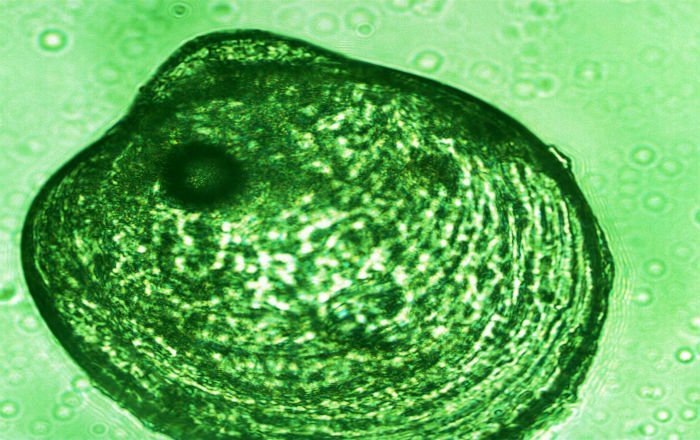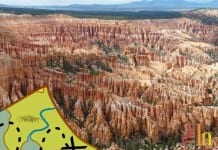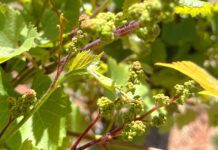 Written by Greta Hyland
Written by Greta HylandIn Oct., 2014, a Bureau of Reclamation (BOR) water quality sampling crew found five quagga mussel veligers in collected water samples across Deer Creek Reservoir. The DWR requested that the samples be genetically analyzed to learn whether they were in fact quagga mussels. Through DNA testing, both the BOR lab and Pisces Molecular, a private third party, confirmed that the veligers were quagga mussels.
For the past couple of years the Department of Wildlife has been working tirelessly in what many see as an impossible mission to keep the invasive quagga mussel out of Utah’s waterways. They regularly take water samples from reservoirs to test for quagga mussels and scuba dive to look for them if there are reports of their presence.
The last two years DWR set up a check point at the port of entry in St.George requiring all watercraft to pull over to be inspected and decontaminated if necessary. They also set up checkpoints around Lake Powell before it was confirmed last year that Lake Powell is infested with them. Now Deer Creek Reservoir might be too.
Starting immediately, you must decontaminate your boat before you leave Deer Creek Reservoir in north-central Utah.
The requirement comes after DNA tests conducted by the two laboratories tested positively for the microscopic juvenile quagga mussels.
Jordan Nielson, aquatic invasive species coordinator for the Division of Wildlife Resources, says the discovery does not mean Deer Creek Reservoir is infested with quagga mussels.
“We’ve found veligers in the past at other waters in Utah,” he says. “With the exception of Lake Powell, mussel populations never established themselves in the waters where veligers were found. We’re hoping that will be the case at Deer Creek too.”
Nielson says quagga mussels usually do not reproduce in water that’s colder than 50 degrees, so—even if there are adult mussels in the reservoir—there’s currently little risk of the population expanding. That could change, though, once the water starts to warm in the spring.
One item biologists and water managers are concerned about now is mussels being carried to other waters in or on boats. That’s why DWR Director Greg Sheehan signed an order on Jan. 15 that requires boats to be decontaminated before leaving Deer Creek State Park. Upon leaving the park, boaters must do one of two things:
 Clean and drain their boat, on their own. After cleaning and draining, a DWR or Utah State Park technician will place a tag on the boat that indicates when it was cleaned and drained. The boat will not be allowed to launch at another body of water in Utah until the boat has dried long enough to kill any mussels that might be in or on it.
Clean and drain their boat, on their own. After cleaning and draining, a DWR or Utah State Park technician will place a tag on the boat that indicates when it was cleaned and drained. The boat will not be allowed to launch at another body of water in Utah until the boat has dried long enough to kill any mussels that might be in or on it.
In the winter, boats must dry for at least 30 days. The drying time can be as little as three days, though, if the temperature remains below 32 degrees Fahrenheit, and then the boat must dry for at least 72 straight hours. They can also have their boat professionally decontaminated. The service is free.
A DWR or Utah State Parks technician will determine whether the boat needs to be professionally decontaminated.
Nielson says the presence of veligers in the reservoir does not mean a quagga mussel population has established itself there. “To establish itself,” he says, “a quagga population needs adult mussels.”
Which raises a question: if there aren’t any adult mussels in the reservoir, where did the juvenile mussels come from?
“This could be an isolated incident,” Nielson says. “For example, it’s possible that the veligers made their way to the reservoir in or on a boat that had been in a contaminated water body. We’ll know a lot more after we and our partners conduct further surveys this spring.”
What’s next?
This spring, the DWR and its partners, including Utah State Parks and the Bureau of Reclamation, will take action to learn whether adult quagga mussels are in the reservoir. That action includes:
– Collecting and analyzing water samples.
– Sending divers into the reservoir, to search for mussels.
– Placing substrate samplers in the water. Adult quaggas attach to these as they move through the water.
– Surveying shorelines.
Water from the reservoir flows into the lower Provo River and then into Utah Lake. Nielson says quagga mussel sampling work has been underway at Utah Lake for years. “The sampling work will continue in 2015,” he says.
Starting this spring, biologists will also sample the lower Provo River.
Nielson says the middle Provo River, the section between Jordanelle and Deer Creek reservoirs, is less at risk. “Quaggas can’t move upstream,” he says. “The only way they could make their way to the middle Provo River is if they were transported there on someone’s boots or fishing equipment.”




